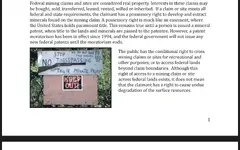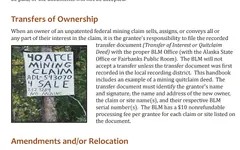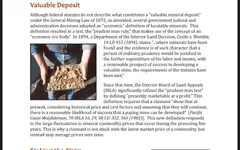Federal Mining Claims Information
ASK THE SELLER:
1. Is the claim state or federal? What is the claim name and number?
2. Who is the owner of record? Claims can have more than one owner. In such cases,
remember if only the interest of one owner is being transferred, you will be a partner with
other owners of record.
3. Ask for a recorded copy of the claim location certificate. All claims must be recorded in
the State Recording District Office in which they are located within 45 days after staking. A
recorded copy of the claim location certificate would have on it the Recording District Office
stamp, date of recording, document number or book and page number.
From this basic information you will have an idea whom to contact for further information.
The current status of a State mineral location can be determined by contacting the
Department of Natural Resources Public Information Center.
These offices maintain all case file records for mineral properties located on State or
State-selected land. If the mineral location is federal, contact the Bureau of Land
Management Public Information Office.
These offices can inform you whether or not the claim is in good standing administratively
by reviewing existing computer data or by existing paperwork available for review in the
case file records; however, other factors enter into claim validity — factors that are often
challenged in a court of law, especially if claim conflicts exist. These could include:
1. Whether the claim was established following the guidelines of appropriate State
or federal regulations, including:
• Whether a “discovery” of a locatable mineral actually took place. The seller
should be able to prove what type of discovery took place, i.e. geochemical
sampling, panning, or drilling. If a visit to the location is possible, obtain
permission to do your own sampling.
• Whether actual claim staking took place. Are posts or monuments erected? Are
boundary lines brushed or flagged? Or, was the claim “paper-staked”?
• Whether the claim was properly recorded within 45 days of the date of staking
in the District Recorder’s Office in which it was located.
2. Whether annual cash rental has been paid in a timely manner. On State
mining claims the rental year begins at noon on September 1 and ends at noon
on September 1 of the following year. Payments must be received no later than
November 30 of the same year. Annual rental amounts vary. For a Traditional
Location it is $35 per year for the first five years; $70 per year for the second five
years; and $170 per year thereafter for up to 40 acre mining claims. The rental for an
MTRSC Location (160 acres) is $140 per year for the first five years; $280 per year for the second five years and $680 per year thereafter. The penalty for failure to
make a timely payment is abandonment of the location.
NOTE: A word of caution, if the staking date of a mining claim on State land is prior
to September 1 of a particular year, two annual rental payments will be required.
The first is due no later than 45 days after the staking date of the location, and the
second, no later than November 30. An Annual Rental “Fact Sheet” is available from
the Public Information Center in Anchorage or Fairbanks.
On federal claims, the maintenance fee is $155 for every 20 acres or portion over 20
for placer claims, or $155 for lode, tunnel, and millsite claims due by September 1
each year. Rental fees for new claims are due when they are filed with the Bureau of
Land Management. Contact the BLM for details.
3. Whether Annual Labor or assessment work has been accomplished on a
continuing basis; was acceptable; and has been properly recorded and filed
according to State or federal regulations. (NOTE: Again, regulations vary
considerably here! Detailed information can be obtained by contacting the
appropriate information source for State and federal claims.)
***Be careful of
claims offered for sale after September 1. This is the end of the annual labor
year on both State and federal claims. Assessment work must have been
accomplished for any specific year prior to that date and recorded no later
than November 30th for the State claims and December 30th for federal
claims. Have the seller show you, in writing, a properly recorded affidavit.
4. Whether the claim is in conflict with other mineral locations. Claim conflicts
do occur and often end up in court when the parties involved cannot resolve the
problem themselves.
AS THE BUYER:
There are other important concerns you should be aware of or have clarified before taking
the big plunge of investing:
1. Is the seller legitimate and reputable? What is their mining, prospecting, or
geological background? Is it documented? If so, how can it be verified?
2. Have any valuable minerals ever been produced or found on the land? Historical
and geological reports on most areas in the State are available through the State
Division of Geological and Geophysical Survey or the U.S. Geological Survey. (See
agency points-of-contact page.)
3. Can the seller produce proof that he has operated on the claim? Depending on the
type of equipment used, permits are normally required before any type of mining
operation can begin. Operators who have submitted Annual Placer Mining Applications
(APMAs) for intended mining activity involving mechanized equipment can be
confirmed through a State Division of Mining, Land and Water Permitting Office.
4. Be aware of what rights you have with a mining claim! A common misconception
is that the buyer is actually buying the land. This is not true, unless the mining
property has been patented under federal law and the owner has title to the land.
(Patents are not issued under State mining laws.) Without a patent, the seller is only
transferring their actual interest in the mining claim to you. Ownership of the land
remains with the State, federal, or local government. As a claim owner, you have the
right to possession and extraction of the minerals; but,:
• You may not use a mining claim for purposes other than mining. Incompatible
uses would include residential use, placing any surface improvement on the
claim without written approval; and use of the claim to pursue recreational or
business interests such as hunting, fishing, trapping, guiding, or outfitting.
• You may not restrict public access without written approval from the land
manager.
• If a third party has interest in the surface estate of a State mining claim, such as
a grazing lease for example, you could be required to reimburse the lessee for
damages caused by the use or development of the location.
5. Is the claim compatible with the type of mining you intend to do? For example,
you intend to conduct suction dredging activities and the claim is located on a
salmon spawning stream. If this is the case, be aware of the time frame restrictions
as to when actual dredging can take place — generally from May 15 to July 15
annually. Note that on federal lands (federal mining claims), suction dredging is
authorized at the discretion of the Authorized Officer. Consultation with the specific
field office of jurisdiction for the area of interest is recommended before suction
dredging decisions are made.
6. Access — Are you familiar with the claim’s general location? Is it reasonably
accessible? If travel “cross country” is involved, check land status. Native corporation
land, parks, refuges, stream crossings, area plans, type of equipment, time frame for
intended travel, restrictive right-of-ways, etc., are potential problem areas. Charter
flights to a “fly-in” only area can be expensive.
7. Water Rights — Are existing water rights associated with the claim? Water
rights are registered with the State of Alaska and a certificate issued by the State’s
Department of Natural Resources, Division of Mining, and Land & Water. Will they
be transferred as part of the purchase? What is the availability of water in that
particular stream during the course of a mining season?
8. What permitting requirements are there for mining activities, which include
transportation of equipment; exploration; or actual mining, in Alaska? It’s important
to know any such activity must be fully permitted before “start-up” can begin.
9. Can mining even be conducted on your claim? In recent years, lawsuits against
the State and federal governments have restricted or stopped mining activity








